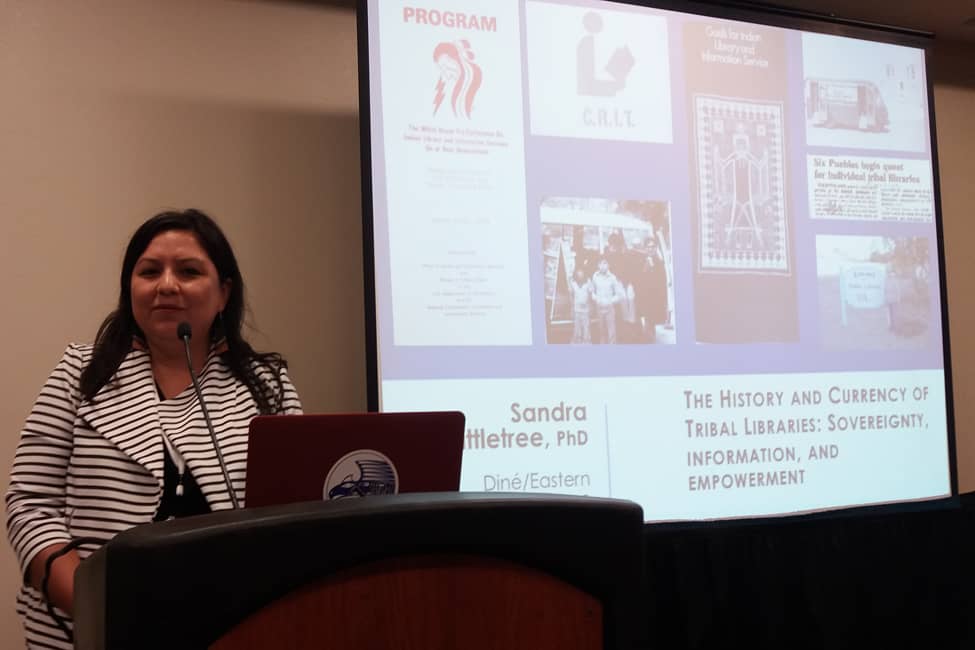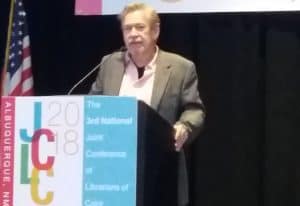
What is the definition of a tribal library? And what is its basis for development?
Sandy Littletree, PhD candidate at University of Washington and 2011–2012 president of the American Indian Library Association (AILA), posed these questions at the outset of “The History and Currency of Tribal Libraries: Sovereignty, Information, and Empowerment,” a September 27 session at the third National Joint Conference of Librarians of Color in Albuquerque, New Mexico.
“There isn’t a lot research about tribal libraries—not a lot has been written officially. This really encouraged me to think of my parents,” said Littletree, who is Navajo/Eastern Shoshone originally from Kirtland, New Mexico. “What types of libraries did they have or didn’t have?”
What emerged from her queries was a dissertation that uses data from unstructured interviews and archival research to present indigenous libraries and librarianship from different angles.
“Tribal libraries are as diverse as tribal communities,” Littletree noted, explaining that libraries can be planned or administered by a tribe, pueblo, village, or native group, and may be located in public libraries, universities, youth centers, chapter houses, or as part of museums and archives.
She found that her sources were painting a bleak history of tribal libraries and librarianship, especially during the 1960s and 1970s. Libraries were either “inadequate or nonexistent,” rooms were filled with broken equipment, books contained “stereotypes and misconceptions of American Indians,” and recruitment of Native Americans to library science programs was poor.
“This is before tribal enterprises like casinos and gaming, so there really wasn’t any funding dedicated to tribal libraries,” Littletree said. It wasn’t until the late-1970s, with actions like the 1975 Indian Self-Determination and Education Assistance Act, 1978 National Indian Omnibus Library Bill, and 1978 White House Pre-Conference on Indian Library and Information Services On or Near Reservations, did a movement of funding and advocacy take root.
“Self-determination is also a key term that kept coming up,” said Littletree. “The idea that tribes had a say in what kind of libraries they want and not just bringing in bookmobiles.”
Littletree’s research set the stage for Aaron LaFromboise, director of library services at Blackfeet Community College in Browning, Montana, and current secretary of AILA, to share a snapshot what her library looks like and how it operates.
Medicine Spring Library at Blackfeet Community College functions as an academic resource, community gathering spot, archives, and cultural center. “Like many libraries, we are a lifeline, whether it’s to use the phone or use the bathroom or just having a public place that meets basic needs,” said LaFromboise.
Securing money for programming and materials is perhaps the biggest challenge. “We don’t have public sources of funding,” said LaFromboise, explaining that their books are donated. “How do you engage people with the current excitement of the literary world if we can’t buy books?”
Lack of funds has led to some creative collaborations and outreach. For instance, Medicine Spring Library has partnered with a “cousin library” to share resources, and the Girl Scouts of Montana and Wyoming sponsor the library’s Lego Robotics kits for youth.
LaFromboise also identified the archives as difficult to maintain. “We are the official tribal archives, which is a blessing and not a blessing,” she said. “We don’t get tribal documents. We built our own archives with what we could.”
LaFromboise thinks one of the questions tribal libraries must answer is, “Where does a tribal council sit with the future of libraries?”
“They have a huge role, but a big part is connecting them with that,” she said. “It’s the place where we tell each other stories.”


